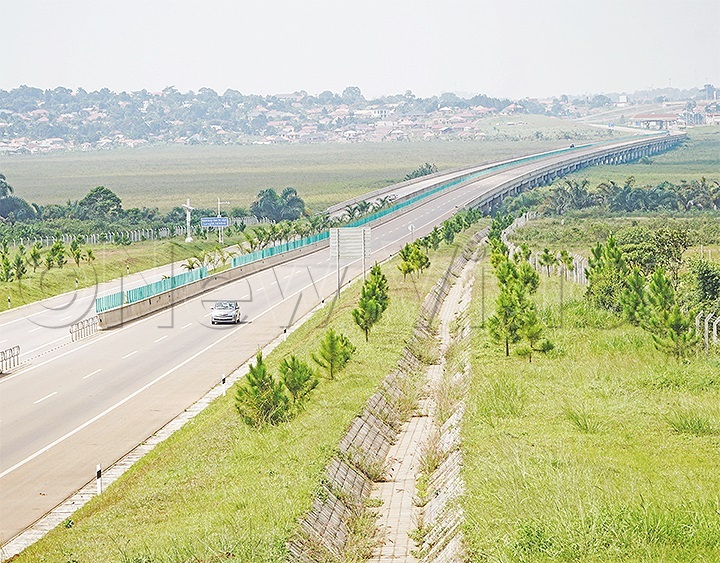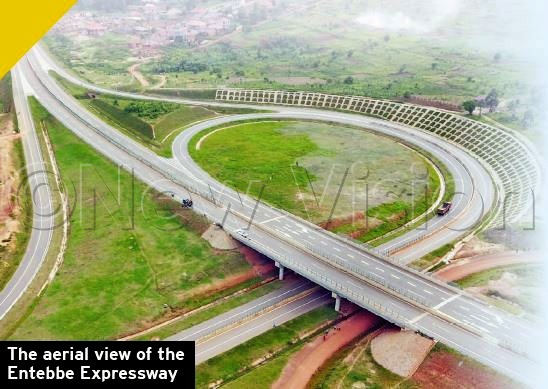Uganda's future is born with a green expressway
Kampala-Entebbe expressway is Uganda’s first road to be suspended over wetlands and is promising to become a blueprint of how concrete infrastructure can be integrated with the natural environment.
ENVIRONMENT INFRASTRUCTURE
On first impression, the Entebbe Expressway shows that Uganda is stepping into the modernity of super-highways. This is the view of Robert Kamya, a resident of Kampala, who has used the expressway and has also travelled to Nigeria and South Africa.
"It is a spectacle," Kamya told New Vision in an interview. "The Kampala- Entebbe expressway is as beautiful as highways in Abuja, Nigeria and Johannesburg, South Africa."
From a distance, you see the work of modern technology as the road snakes into the peri-urban areas, sitting in the southern parts of the Greater Kampala and Wakiso district. The road was constructed to connect Kampala to the Entebbe airport.
Besides its beauty, the Kampala-Entebbe expressway is also ecofriendly. The rich ecological assets, such as wetlands, were left intact as the highway is suspended over swathes of the marshes. The wetlands play the time-honoured roles of cleaning wastewater and storing water.
The Uganda National Roads Authority (UNRA) is also planting trees along the expressway, to help absorb waste gases, such as carbon dioxide, which is one of the emissions blamed for causing climate change.
Kampala-Entebbe expressway is Uganda's first road to be suspended over wetlands and is promising to become a blueprint of how concrete infrastructure can be integrated with the natural environment.
This marriage is what is needed to save the wetlands linking expansive urban centres, like Kampala and Entebbe, which are connected to Lake Victoria by greenery.
As the superhighways evacuate the traffic, the "green infrastructure" or the wetlands, clean out wastewater from Kampala, before releasing the clean water into the lake. Wetlands also act as breaks, helping to prevent floods. They are also breeding grounds for fish, helping to replenish the lake, which is one of the biggest sources of fish for domestic consumption and export.
"This is what we have been advocating. Infrastructure is needed, but it should not cross the wetland," Lucy Iyango, the acting national project co-ordinator of the climate resilience programme in the environment ministry, said.
"That is the way to go because it improves the aesthetics of the environment."

She also pointed out that Uganda is one of the countries with the highest number of peat in the wetlands. The peat store a lot of greenhouse gases and, building over wetlands, releases the gases into the atmosphere, leading to climate change.
Similarly, the trees and the forest cover are connected to urban areas, such as Kampala.
The trees act as a sink for heavy emissions of carbon from old cars and mushrooming industries around the cities. They are lifelines in sustainable cities, needed in the fight against climate change.
Expensive road
UNRA spokesperson Allan Ssempebwa says the Kampala-Entebbe expressway, which cost $476m (about sh1.8 trillion) is one of the most expensive roads in the world because it had to spare the ecologically fragile ecological assets.
He pointed out that the expressway traverses five swamps and has four interchanges at Busega, Kajjansi, Lweza and Mpala. It also crosses 14 seasonal swamps, stretching 6km, has three toll plazas, one-foot tall bridge, vehicle overpass bridges, pedestrian overpass bridges and water bodies overpass bridges.
"It is important to note that saving the environment came at a high cost and, therefore, explains some of the cost drivers on such huge road projects," he said.
He also explained that the construction of the Kampala-Entebbe expressway is expected to cut travel time around the central business district since it offers fast connectivity between Entebbe and Kampala.
"Its viability is, therefore, measured in the levels of traffic the road has registered since it was opened. It has tremendously cut down on traffic on the existing old Entebbe Road. It is, therefore, a viable alternative link," he said.
The Kampala-Entebbe expressway is part of the road ring with forthcoming projects, such as Kibuye, Busega, Mpigi expressway and the completion of the Northern Bypass project, being vital assets to traffic or motorists.
Background
UNRA is taking big lessons from their previous failures by putting in place environmental and social standards.
"You may recall that in 2015, the World Bank pulled the plug on financing of the Fort Portal-Kamwenge Road, citing gross abuse and violence towards women and children. The move affected other World Bank-financed road projects," Ssempebwa told New Vision.
"This came at a time when Kagina had just assumed office and part of her administration's reforms included mitigating social risks along road works, the first of its kind in the roads sector."

Indeed, with high chances of stalling an illustrious project, the Government committed funds to complete the road and these were completed in 2017.
"UNRA took it as a wake-up call and continued to strengthen its social safeguard function through intensified monitoring to ensure compliance from the contractor," he said. This development gave birth to the UNRA Environment and Social Safeguards Policy.
UNRA now has a fully-fledged department to develop, disseminate, review and update environmental and social management systems, as well as monitor compliance with the procedures.
"We have made attempts to integrate environmental and social considerations into project design and eventual implementation," he said.
Northern bypass on wetland
The work on the Northern Bypass is the opposite of the achievements on the Kampala-Entebbe expressway.
The road linking Busega and Bweyogerere, as well as areas sitting in the northern parts of Kampala, is sitting on vital wetlands.
Ssempebwa denied reclaiming swamps to pave way for the Northern Bypass. He said they have provided drainage boxes to improve drainage at Lubigi.
"We have made provisions for good drainage. We have not reclaimed," he said. "The road is on the side. We have provided big box culverts. We know that floods are going to be history."
Asked whether they were constructing the Northern Bypass on the swamp at Kalerwe, he said: "The area that we have taken over at Kalerwe, there were buildings." He added: "We want to provide solutions to areas where floods occur. We call upon the communities and their leaders to work with us to clean the environment."

"We all want to live in an environment that is safe."
Away from the Northern Bypass and the Entebbe Expressway, the utility agencies, including Umeme, keep cutting down trees growing towards the power line.
"Utility companies should work with UNRA and Kampala Capital City Authority (KCCA) to ensure that appropriate trees are planted or regular pruning takes place, to ensure that the trees do not grow out of hand," Abbey Kalema, a landscaper in Kampala, said.
He added that it takes resources to get good tree seedlings and care for them, but this goes down the drain when the trees are cut down.
Stephen Kato, a landscape officer under the environment department of KCCA, said they were working with different partners to plant trees and that they were avoiding to plant trees below power lines.
"There are trees that grow tall and they should not be planted below power lines," Kato said.
‘Green right of way'
The saying that charity begins at home is something that Uganda has not forgotten when it comes to fighting climate change. This fight has been taken up by the Uganda National Roads Authority, to the epic battle with emissions produced on the roads.
"The emission levels are very high, but there are no carbon sinks," Allen Kagina, UNRA's director-general, said, adding that the authority is constructing roads to connect people moving to different places, but also have a bigger responsibility to establish carbon sinks.
She said: "We need to plant the trees along the roads across the country."
She added that UNRA is embracing tree planting because a mature tree can absorb up one tonne of carbon dioxide, which will help reduce global warming and climate change. UNRA's intervention, also referred to as Green Right of Way has embraced planting of indigenous and exotic trees, such as mahogany, one of the most treasured hardwood tree species globally and pines along the Entebbe Expressway.
What is Climate change?
Climate change is caused by emissions, such as carbon dioxide, from production processes, which trap heat escaping to the atmosphere, thereby causing global warming. The emissions that are blamed for causing climate change are known as greenhouse gases (GHG).
The warming of the earth disrupts rainfall patterns and melts ice on mountain tops, like the Rwenzori. It also accelerates droughts and floods, as well as landslides that are becoming frequent in different parts of the country.
As impacts of climate change increase, the global community is taking measures to reduce the GHG.
Uganda is a signatory to the Paris Agreement on Climate Change, which aims at reducing the warming of the earth. The agreement's central aim is to strengthen the global response to the threat of climate change by keeping a global temperature rise below two degrees Celsius above preindustrial levels, according to the United Nations Framework Convention on Climate Change (UNFCCC).
It also aims at supporting efforts to limit the temperature increase even further to 1.5 degrees Celsius.
Statistics
The expressway spans 36.94km from Kampala to Entebbe and 12.62km from Kajjansi to
Munyonyo. The road starts ascending a few metres away from the point where it joins the Northern Bypass, between Busega and Masanafu intersections, passing over Kampala-Mityana Road.
There are suspended bridges over Lubigi swamp at Busega, covering 200 metres. Near Kyengera is a bridge estimated at half a kilometre and at the Nambigirwa swamp of 1.45km.
The story was done with the support of InfoNile